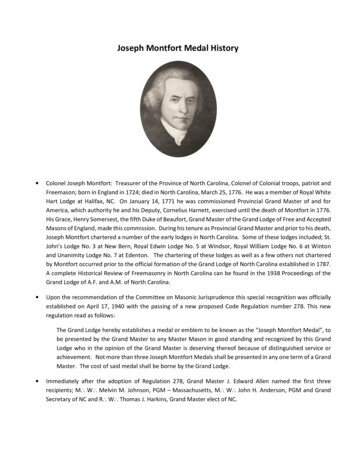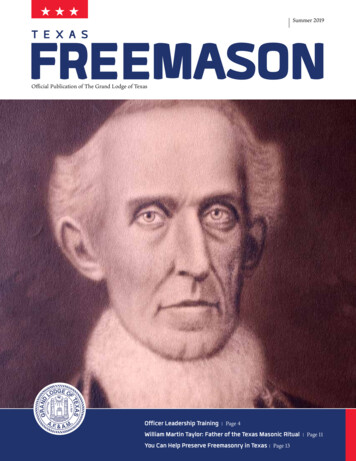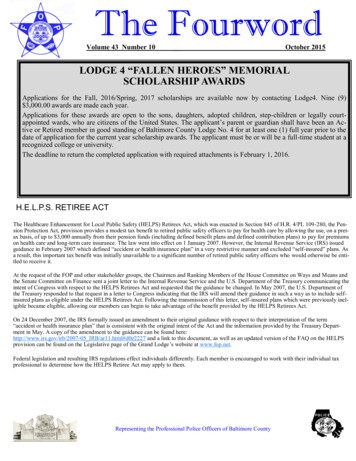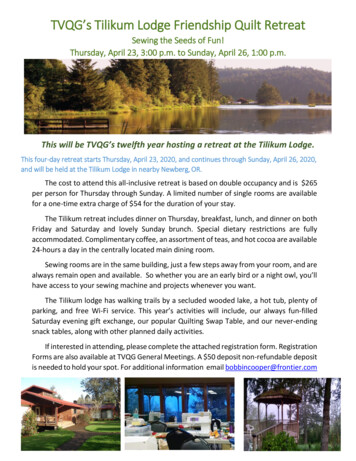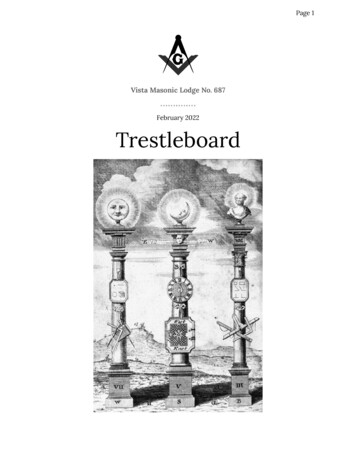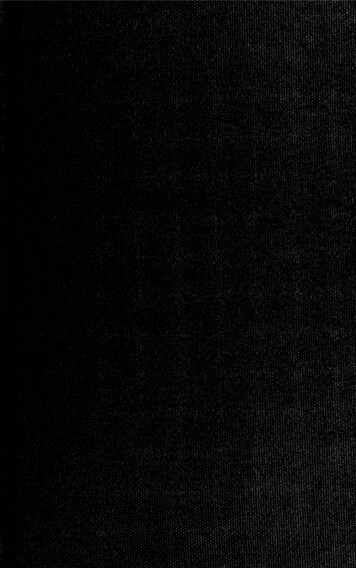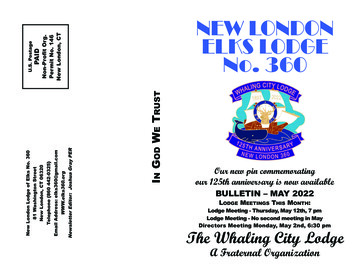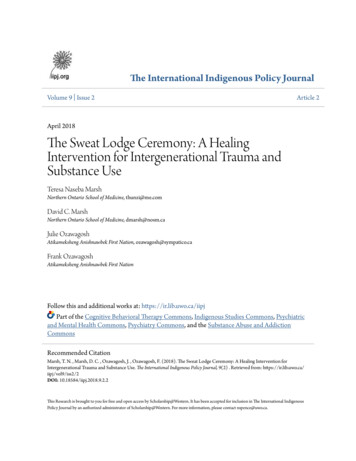
Transcription
The International Indigenous Policy JournalVolume 9 Issue 2Article 2April 2018The Sweat Lodge Ceremony: A HealingIntervention for Intergenerational Trauma andSubstance UseTeresa Naseba MarshNorthern Ontario School of Medicine, thunzi@me.comDavid C. MarshNorthern Ontario School of Medicine, dmarsh@nosm.caJulie OzawagoshAtikameksheng Anishnawbek First Nation, ozawagosh@sympatico.caFrank OzawagoshAtikameksheng Anishnawbek First NationFollow this and additional works at: https://ir.lib.uwo.ca/iipjPart of the Cognitive Behavioral Therapy Commons, Indigenous Studies Commons, Psychiatricand Mental Health Commons, Psychiatry Commons, and the Substance Abuse and AddictionCommonsRecommended CitationMarsh, T. N. , Marsh, D. C. , Ozawagosh, J. , Ozawagosh, F. (2018). The Sweat Lodge Ceremony: A Healing Intervention forIntergenerational Trauma and Substance Use. The International Indigenous Policy Journal, 9(2) . Retrieved from: https://ir.lib.uwo.ca/iipj/vol9/iss2/2DOI: 10.18584/iipj.2018.9.2.2This Research is brought to you for free and open access by Scholarship@Western. It has been accepted for inclusion in The International IndigenousPolicy Journal by an authorized administrator of Scholarship@Western. For more information, please contact nspence@uwo.ca.
The Sweat Lodge Ceremony: A Healing Intervention for IntergenerationalTrauma and Substance UseAbstractMany traditional healers and Elders agree that strengthening cultural identity, incorporating traditionalhealing practices, and encouraging community integration can enhance and improve mental health andreduce substance use disorders (SUD) in Indigenous populations. Despite the fact that traditional healingpractices have always been valued by Indigenous Peoples, there is very little research on efficacy. Recentresearch by one of the authors in this group (T. Marsh) has shown that the blending of Indigenous traditionalhealing practices and a Western treatment model, Seeking Safety, resulted in a reduction in intergenerationaltrauma (IGT) symptoms and substance use disorders (SUD). This article focuses on the qualitative evidenceconcerning the impact of the traditional healing practices, specifically the sweat lodge ceremony. Participantsreported an increase in spiritual and emotional well-being that they said was directly attributable to theceremony. This study demonstrates that it would be beneficial to incorporate Indigenous traditional healingpractices, including the sweat lodge ceremony, into Seeking Safety to enhance the health and well-being ofIndigenous Peoples with IGT and SUD.Keywordspost-traumatic stress disorder, PTSD, substance use disorder, intergenerational trauma, two-eyed seeing,Seeking Safety, traditional healing practices, decolonizing methodologies, Indigenous worldviews, sweatlodge, sharing circles, EldersCreative Commons LicenseThis work is licensed under a Creative Commons Attribution-Noncommercial-No Derivative Works 4.0License.This research is available in The International Indigenous Policy Journal: https://ir.lib.uwo.ca/iipj/vol9/iss2/2
Marsh et al.: Sweat Lodge Ceremony for Addiction and TraumaThe Sweat Lodge Ceremony: A Healing Intervention forIntergenerational Trauma and Substance UseThe contemporary challenges of violence, substance use, intergenerational traumasymptomology, and mental health problems in Indigenous communities are an indication of theimpact of colonization, including residential schooling and other factors, on individuals, families,communities, and nations (Aguiar & Halseth, 2015; Bombay, Matheson, & Anisman, 2014;Miller et al., 2011; Spittal et al., 2007). Barman (1996) stated, “the high rates of impoverishment,incarceration, suicide and alcoholism in Canadian Indigenous peoples, can be traced back to theabuse received at residential schools” (p. 273). Familial fragmentation and disintegration areevident in Indigenous communities where interpersonal, individual, and familial violence, as wellas drug and alcohol dependence are pervasive (Bombay et al., 2014; Chansonneuve, 2007; Kerret al., 2009; Spittal et al., 2007; Wood et al., 2003). The blending of Western approaches andtraditional healing (or attention to culture) has been reported as a successful element insubstance use disorder (SUD) programs designed for Indigenous Peoples (Jane & GlodeDesrochers, 2014; Tousignant & Sioui, 2009; Whitbeck, Adams, Hoyt, & Chen, 2004).A few case studies report the incorporation of healing rituals into conventional counselling andtreatment interventions (Bombay et al., 2014; Brave Heart, 1998; Duran, 2006b; Robbins &Dewar, 2011). Scholars, traditional healers, and Elders encourage and utilize integration;however, some feel that these approaches require additional scientific evidence to support theiruse (Hill, 2003; Poonwassie & Charter, 2005; Stubley & Rojas, 2014). Currently, IndigenousPeoples and communities are challenged by the huge service gaps in areas such as withdrawalmanagement, trauma treatment, aftercare, and psychiatric care (Hart, 2007; Jane & GlodeDesrochers, 2014; Spittal et al., 2007). Recent studies demonstrate that it could be beneficial toincorporate Indigenous-healing practices into the Western treatment model Seeking Safety(Marsh, Young, Meek, Najavits, & Toulouse, 2016; Marsh, Cote-Meek, Young, Najavits, &Toulouse, 2016; Najavits, 2002). Furthermore, this integration could enhance the health andwell-being of Indigenous people with intergenerational trauma (IGT) and SUD (Marsh, CoteMeek, et al., 2016; Marsh, Young, et al., 2016). One of the key components of the IndigenousHealing and Seeking Safety (IHSS) intervention was the sweat lodge ceremony. While the broadset of Indigenous healing practices utilized in the previous study of IHSS are discussedelsewhere (Marsh, Coholic, Cote-Meek, & Najavits, 2015; Marsh, Cote-Meek, Toulouse,Najavits, & Young, 2015; Marsh, Cote-Meek, et al., 2016), this article explores in-depth theapplication of the sweat lodge ceremony as a component of IHSS.Literature ReviewThe key to healing following the experience of residential school abuse and its intergenerationaleffects lies in the area of reclaiming identity (Bombay et al., 2014; Kovach, 2010; Smith, 1999;Waldram, 1997). Reclaiming Indigenous identity means recovering traditional values, beliefs,philosophies, ideologies, and approaches, and adapting them to the needs of today (Brave Heart,1999; Chansonneuve, 2007; Duran & Duran, 1995; Evans-Campbell, 2008; Kovach, 2010;Marsh, Coholic, et al., 2015). This reclamation process encompasses both individual andcollective identity, and it can be sought by way of traditional healing methods.Published by Scholarship@Western, 20181
The International Indigenous Policy Journal, Vol. 9, Iss. 2 [2018], Art. 2According to the World Health Organization (2000), the term traditional medicine refers to:The sum total of knowledge, skills, and practices based on the theories, beliefs, andexperiences Indigenous to different cultures, whether explicable or not, used in themaintenance of health as well as in the prevention, diagnosis, improvement of treatmentof physical and mental illness. (p. 1)The Report of the Royal Commission on Aboriginal Peoples (1996) defined traditional healingas:Practices designed to promote mental, physical, and spiritual well-being that are basedon beliefs which go back to the time before the spread of Western ‘scientific’ biomedicine. When Indigenous peoples in Canada talk about traditional healing, theyinclude a wide range of activities, from physical cures using herbal medicines and otherremedies, to the promotion of psychological and spiritual well-being using ceremony,counselling and the accumulated wisdom of Elders. (p. 348)There appears to be a consensus amongst researchers and practitioners that restoring traditionalhealing practices and knowledge is a pathway to both empowerment and health for Indigenouspeoples and communities (Brave Heart, 2003; Duran, 2006; Hill, 2009; Menzies, 2014).However, in order to achieve this goal, the traditional knowledge once practiced in historicalIndigenous societies needs to be restored and included in the interventions aimed at addiction,trauma, and the epidemics facing Indigenous peoples (Duran, 2006; Thatcher, 2004). While it isa common Indigenous belief that traditional culture and knowledge are important for promotingcommunity health and well-being, little effort has been made to investigate the healing benefitsthat Indigenous people have always acknowledged (Duran & Duran, 1995; Mussell, 2005; RoyalCommission on Aboriginal Peoples, 1996; Warry, 2008).Although sweat lodge ceremonies have historically been an important part of Indigenouscultures throughout North America, little evidence supports the efficacy of this intervention.However, there is now a revival of traditional Indigenous ceremonies, and both Indigenous andnon-Indigenous peoples have increasingly utilized the sweat lodge ceremony as a means ofhealing in multiple dimensions of body, mind, emotion, and spirit (Moodley & West, 2005;Royal Commission on Aboriginal Peoples, 1996; Walkingstick & Larry-Osborne, 1995). Also,sweat lodge ceremonies are now offered in prisons and substance use treatment centers, andtreatment providers agree to its recognition and growing acceptance as an important aspect ofhealing for Indigenous Peoples (Colmant, Eason, Winterowd, Jacobs, & Cashel, 2005; Gone &Waldram, 2008; Kovach, 2010; Stewart, 2008).The universality of the sweat lodge ceremony among Indigenous Peoples—including AmericanIndian tribes from coast to coast, in Alaska, across Canada, and in Mexico—is well documented(Colmant et al., 2005; Colmant & Merta, 2000). Furthermore, evidence of North AmericanIndigenous Peoples using the sweat lodge ceremony can be found as early as 400 B.C. (Abdullah& Stringer, 1999; Brave Heart, 1998; Colmant et al., 2005). There are differences in rituals andtraditions associated with the sweat lodge ceremonies. These differences are dependent onhttps://ir.lib.uwo.ca/iipj/vol9/iss2/2DOI: 10.18584/iipj.2018.9.2.22
Marsh et al.: Sweat Lodge Ceremony for Addiction and Traumalocation, territory, and cultural practices. For example, some ceremonies may include drummingand gift offerings to the ancient ones, while in other cases it could be part of a Sun Dance.Colmant et al. (2005) found that use of the sweat lodge supported the building of groupcohesion, which many Indigenous Peoples in North America have also reported. Many Eldersand traditional healers teach about the connections to spirit, family, and friends that are sharedand cultivated in a sweat lodge ceremony (Marsh, Cote-Meek, et al., 2016; Menzies, Bodnar, &Harper, 2010). Furthermore, Elder Rolling Thunder, in his teachings, highlights the importanceof laughter, presence, and support to others in the sweat lodge (cited in Crow, Mails, & Means,2001). Elders teach that the sweat lodge ceremony serves a sacred purpose through the ritualhealing or cleansing of body, mind, and spirit while bringing people together to honour theenergy of life (personal communication Elders Julie and Frank Ozawagosh, January 5, 2013).The Elders teach that each person enters the lodge with his or her own challenges, suffering,conflicts, addiction, and concerns. This sitting together brings connection, truth, harmony, andpeace through sweating, praying, drumming, sharing, stories, and singing.There appears to be a scarcity in the research literature reporting the effectiveness of the use ofthe sweat lodge in contemporary settings. Schiff and Moore (2006) examined the impact of thesweat lodge, examining the outcomes in the spiritual, emotional, mental, and physical realms byinterviewing 42 Indigenous and non-Indigenous individuals with experience of sweat lodgeceremonies over a period of 4 months. Changes in quality of life, health, and spiritual andemotional well-being were measured using the SF-36 quality of life measure, the Heroic MythIndex, and a multipurpose health index. Results showed a significant increase in spiritual andemotional well-being. They concluded that this outcome was directly attributable toparticipation in the ceremony (Schiff & Moore, 2006).Over a three-year period, Gossage et al. (2003) explored the impact of sweat lodge ceremonieson inmates at the Dine' Center for Substance Abuse Treatment. Participants included 123inmates ranging in age from 18 to 64 years, and all were included in the sweat lodge ceremonies.Four self-administered questionnaires were developed to gather data from the inmates. Resultsshowed significant improvement in several cultural, social, and physical variables, includingincreases in the participants' relationship to the mineral, animal, and human world; increases inthe level of social and family support; decreases in violent acts; decreases in medical problemsand the degree to which participants were bothered by those medical problems, along withincreases in feelings of overall physical wellness; and substantial improvement in maritalrelationships (Gossage et al., 2003). In another study, the authors reported that they observedsweat lodge participants were less worried and had a higher level of self-esteem (Ross & Ross,1992). In a review of the literature, Colmant and Merta (1999) found that many AmericanIndians spoke about the importance of socialization and friendship and the healing propertiesthat come with laughter in a sweat lodge.In a recent study that reviewed the literature on interventions to treat SUDs in Indigenouspopulations, Rowan et al. (2014) reported:Seventeen types of cultural interventions were found, with sweat lodge ceremonies themost commonly (68%) enacted. Study samples ranged from 11 to 2,685 clients. JustPublished by Scholarship@Western, 20183
The International Indigenous Policy Journal, Vol. 9, Iss. 2 [2018], Art. 2over half of studies involved quasi-experimental designs (53%). Most articles (90%)measured physical wellness, with fewer (37%) examining spiritual health. Results showbenefits in all areas of wellness, particularly by reducing or eliminating substance useproblems in 74% of studies. (Abstract, Results section, para. 1)While many of the studies on sweat lodge ceremonies support the effectiveness of theintervention and blending Western and Indigenous approaches to healing from SUD, noneaddressed the integrated treatment of IGT and SUD.MethodsThis study seeks to explore in detail the sweat lodge ceremony as a component of theIndigenous healing practices utilized during Najavits’ study (2002), which demonstrated theintegration of Indigenous traditional healing practices into the Seeking Safety model produced afeasible, suitable, and beneficial group treatment for IGT and SUD in Indigenous women andmen (see also Marsh, Young, et al., 2016; Marsh, Cote-Meek, et al., 2016). A qualitative,Indigenous decolonizing methodology was used during this project. The two-eyed seeingapproach was used to guide this research process. This approach was selected because it alignswith decolonizing and Indigenous research methodologies (Kovach, 2010; Smith, 1999; Wilson,2008). Many Indigenous scholars agree that the process of decolonization requires ethically andculturally acceptable approaches when research involves Indigenous Peoples (Menzies et al.,2010; Smith, 1999; Wilson, 2008). The two-eyed seeing approach is consistent with Aboriginalgovernance, research as ceremony, and self-determination. In other words, it is consistent withthe principles of ownership, control, access, and possession (OCAP ; First Nations InformationGovernance Centre, 2007; National Aboriginal Health Organization [NAHO], 2008; Wilson,2008).A previous study by Marsh, Cote-Meek, et al. (2015) utilized a mixed-methods approach, whichincludes both quantitative and qualitative methods, guided by cultural ethics and protocols. Thequalitative findings for this article are drawn from this study. It was also critical to conduct thisresearch in a honourable, honest, respectful, and humble manner. Cultural knowledge carriers,including Elders, an Indigenous advisory group, Indigenous scholars, and clinicians, were invitedinto this process as consultants. The presence of an Elder in the sharing circles and sweat lodgeceremony was an important healing practice within the two-eyed seeing approach. AboriginalPeoples have long recognized the role of the Elder as integral in the healing process. Elders’ skills,knowledge, and their ability to help individuals restore balance in their lives have earned them asignificant place within Aboriginal communities (Menzies et al., 2010). The Elder’s presence inthe sharing circles was reflexive and culturally adaptive. The Elder taught about two-eyed seeing,while also focusing on the positive identity of each person in the circle. They also helped todevelop a connection to the spiritual world through their teachings. The teachings, wisdom,guidance and feedback of these knowledge carriers were critical to the success of this research.The results of the qualitative and quantitative outcomes of the IHSS intervention are discussedin separate articles (Marsh, Young, et al., 2016; Marsh, Cote-Meek, et al., 2016). The purpose ofthis article is to give a more detailed description of one of the cultural interventions, the sweatlodge ceremony, drawn from the qualitative data.https://ir.lib.uwo.ca/iipj/vol9/iss2/2DOI: 10.18584/iipj.2018.9.2.24
Marsh et al.: Sweat Lodge Ceremony for Addiction and TraumaMethodological OverviewWhile the detailed methodology of the IHSS study has been reported elsewhere (Marsh, CoteMeek, et al., 2015), the approach utilized to generate the qualitative data on sweat lodgeceremonies is briefly described below. Four facilitators and two students were selected to leadthe Seeking Safety groups, which for our purposes were called sharing circles. The Eldersadvised that these individuals should be Indigenous and have experience working withIndigenous Peoples. All four facilitators had previous experience working with women and menwho have experienced IGT and SUD. As a competent practitioner in the Western Seeking Safetymodel, the first author trained the facilitators in group facilitation and delivery of the sharingcircles. The training lasted for 1 week, 8 hours per day, and consisted of didactical, experiential,small-group learning, and practice sessions. The training was video recorded so that facilitatorscould critically reflect on their techniques. Furthermore, discourse on group methods, groupprocess, therapeutic use of self, and expectations were included. The facilitators offered tobaccobundles to participants, which had been prepared ahead of time. The facilitators took time toexplain the respectful rules for the sharing circles. The first author remained mainly in thebackground, but was always present to help and support. Since the first author interviewed allthe participants, they welcomed her presence and at times would invite her into the circle to givea teaching.Participants were recruited by counsellors and healthcare workers from the following locations:N’Swakamok Native Friendship Centre, Iris Addiction Recovery for Women, Salvation ArmyAddiction Treatment Centre, Waters of Change Counselling Centre, Rockhaven RecoveryHome for Men, Shkagamik-Kwe Health Centre, and Ontario Addiction Treatment Centers(OATC) Sudbury. In addition, participants were also recruited via workers on reserve in thearea surrounding Sudbury. Referrals were sent to the first author who held appointments withprospective participants.A convenience sampling approach was used to recruit 24 participants (12 women and 12 men)who self-identified as Indigenous. All participants were willing to accept a method of treatmentthat incorporated Indigenous traditional healing practices. In addition, all participants residedoff reserve in Northern Ontario and were between the ages of 24 and 68 years (with an averageage of 35 years). Of the 24 participants, 16 identified as Ojibway, 2 as Cree, and 6 as Métis.Furthermore, all participants self-reported that they had IGT and SUD (actively using or not),no active psychosis, no acute withdrawal, and no current suicidality or homocidality. Thecultural informants deemed self-reporting culturally appropriate for identifying substance useand trauma symptoms. The Laurentian University Research Ethics Board approved this study inMay 2013. Written informed consent was obtained from all participants.IHSS InterventionAn initial 90-minute meeting was conducted with each of the participants. During thesemeetings, participants received information about Seeking Safety, traditional healing, sharingcircles, sweat lodge ceremonies, and the program details. The men’s sharing circles (n 12participants) took place at the Rockhaven Addiction Recovery Home for Men, located inPublished by Scholarship@Western, 20185
The International Indigenous Policy Journal, Vol. 9, Iss. 2 [2018], Art. 2Sudbury, Ontario. The female sharing circles (n 12 participants) took place at theN’Swakamok Native Friendship Centre in the same city. Each of the sharing circles were cofacilitated by two Indigenous healthcare workers and one student and included both SeekingSafety material and approaches. These facilitators organized and led sharing circles twice a weekfor both the male and female circles for 13 weeks. Each weekly sharing circle was 2 hours long.To encourage a holistic view of mental health and substance use (which includes connection tocommunity), many Indigenous protocols were incorporated into the sharing circles. Eachsharing circle was opened and closed with smudging, ceremonial drumming, and singing.Tobacco, a plant recognized in Indigenous culture for its sacred and healing powers, wasprepared in bundles in advance of the sharing circles. It was offered to each participant forprotection and healing. Participants were also invited to participate in three sweat lodgeceremonies held in Weeks 3, 9, and 12 of the intervention period.Data AnalysisThe data analysis approach and results have been published in an earlier paper (Marsh, CoteMeek, et al., 2016). All discussions from the sharing circles and the semi-structured interviewswere audiotaped and transcribed verbatim in Microsoft Word using numbers to maintainparticipant confidentiality. After transcription, a qualitative thematic analysis was performed tosearch for themes that emerged from the text of each individual post-treatment semi-structuredinterview, and the end-of-treatment sharing circles. Themes were identified via careful readingand re-reading of the data by the primary author. The identified themes were then categorized aspattern recognition occurred. The following four core themes were identified:a. Healing through traditional Aboriginal healing methods;b. Education and knowledge about Seeking Safety and material;c. Awareness and understanding of the link between trauma, substance use, and theimpact of colonization; andd. Integration and application of knowledge.During data analysis, the Elders explored the four core themes and decided that these themesconnected with the teachings in the Medicine Wheel. Based on the recommendation of theElders, the results were depicted through the lens of the Medicine Wheel (Marsh, Young, et al.,2016; Marsh, Cote-Meek, et al., 2016), in order to authenticate the Indigenous decolonizingmethodology of two-eyed seeing (Marsh, Young, et al., 2016; Marsh, Cote-Meek, et al., 2016).Next, member statements that corresponded to a specific theme were identified andtransformed into meaningful units, and then coded into subthemes.The Sweat Lodge CeremoniesThe sweat lodge ceremonies were conducted by Elders Julie and Frank Ozawagosh from theAtikameksheng Anishnawbek (Whitefish Lake) community. These sweat lodge ceremonieswere offered in the above-mentioned community and the lodge was built by Elder FrankOzawagosh. Elder Julie taught that the sweat ceremonies helped repair the damage done to thespirits, minds, and bodies of the participants. During the sweat ceremonies, Elder Julie gavehttps://ir.lib.uwo.ca/iipj/vol9/iss2/2DOI: 10.18584/iipj.2018.9.2.26
Marsh et al.: Sweat Lodge Ceremony for Addiction and Traumateachings about Indigenous traditional healing and its restorative power. Participants were alsoinvited to share their stories and experiences. Three sweats were offered for each of the groupsover the period of three months. The Elders and the advisory group recommended that sharingcircles and sweat lodge ceremonies be offered separately to male and female participants. TheElders advised that gender division was important to ensure that participants felt comfortableand safe during the sharing circle sessions. However, the male and female facilitators attendedboth sets of ceremonies to offer additional support. Not all participants were able to attend theceremonies; on average, 8 of 12 participants were present. Consent from participants wasobtained for the sweats. The sweats were conducted in a dome-shaped and circular lodge, builtlow to the ground.Teachings, Preparations, and ProtocolsAll the participants and facilitators received teachings from Elders Julie and Frank before theyparticipated in a sweat lodge ceremony. The Elders taught that even people that are experiencedwith sweats, and attending a ceremony led by a properly trained ceremonial leader, couldsuddenly experience problems due to underlying health issues. They recommended that peopleonly attend lodges with traditional spiritual leaders who are recognized by their community toconduct ceremonies. Elder Frank also gave a powerful teaching about the preparations beforethe sweat lodge ceremony. For example, the collection of the rocks (grandfathers) and the woodfor the fire, as well as the cleaning of the lodge is a sacred ritual that is performed weeks beforethe sweat ceremony. This teaching helped the participants to appreciate and respect the creationand hard work of Elder Frank. Furthermore, Elder Julie talked about the physical risks related tothe reports of lodge-related deaths resulting from overexposure to heat, dehydration, smokeinhalation, or improper lodge construction leading to suffocation. She assured us that she andher helpers were trained and well aware of risks, and that they took precautions to avoid thesekinds of accidents by using proper technique. The lodge was properly constructed with greatcare, and with respect for the environment, and for the materials being used. Elder Julie alsotalked about the precautions with regards to heat exposure and explained that it gets very hot inthe sweat lodge. The rocks used to heat it are glowing red and water is poured on them to createsteam that is at least as hot as the boiling point of water. Participants were also taught to leavethe lodge if they experience discomfort. Simple garments were recommended: men wore shortsand women wore a loose dress or skirt. Participants were asked to bring two towels into thelodge with them: one with a wet corner to help with breathing at hotter moments and to wipethe sweat, if desired, and the other for use for personal waste: For example, if the participant feltthe urge to spit. Two persons remained outside the sweat lodge to protect the ceremony, assistthe participants, and aid with lodge etiquette. Some of the participants who could not toleratebeing inside the sweat lodge had the option to sit outside of the lodge with Elder Frank andcould still receive the benefits of the ceremony. The facilitators, students, and the first authorattended all the sweats and provided support to the participants. The duration of each of thesweat ceremonies was about one and a half hours.Many of the participants shared that they never had a sweat before and some stated that it hasbeen years since their last sweat (see Garrett & Garrett, 2002; Marsh, Young, et al., 2016; Marsh,Coholic, et al., 2015; Marsh, Cote-Meek, et al., 2015). Elder Julie continued the teachings withPublished by Scholarship@Western, 20187
The International Indigenous Policy Journal, Vol. 9, Iss. 2 [2018], Art. 2the sweat lodge itself as a return to the womb of Mother Earth. The rock pit was in the center ofthe lodge and the participants sat along the sides of the pit facing the four directions: East, South,West, and North. Elder Frank, the Fire Keeper, had the responsibility of tending the sacred firein which the ceremonial rocks were being heated. Participants entered one by one, on theirhands and knees to show humility and respect for the Earth. Next, the rocks were brought intothe lodge, arranged to represent the four directions, and the flap or door opening was sealed shut.The darkness in the lodge brings forth and symbolizes the darkness of the spirit, our ignorance,and indicates the healing and cleansing needed so that the light can come in (Garrett, Brubaker,Torres-Rivera, West-Olatunji, & Conwill, 2008; personal communication Elder Julie and FrankOzawagosh, October 5, 2013).The ceremony began with Elder Julie drumming and encouraging those with drums and shakersto join her. After the drumming, the Elder initiated the ceremony with prayers in her Ojibwaymother tongue, thanking the Creator, ancestors, and spirit guides and animals. This wasfollowed by a vocation to the Great Spirit, Mother Earth, the four directions, and the spirits bythe pouring of special water and an herbal mixture (sage and cedar) over the heated rocksproducing a purifying steam that fills the lodge. The Elder then asked the participants to sharestarting in the west and proceeding around to the east side of the lodge. This was repeatedseveral times in cycles known as rounds. Participants first shared their needs and cried and/orprayed for themselves, their families, friends, each other, and asked for wisdom, forgiveness, andhealing from their IGT and SUD. After each sharing, the Elder and participants would thank theCreator, and the Grandmothers and Fath
healing practices and a Western treatment model, Seeking Safety, resulted in a reduction in intergenerational trauma (IGT) symptoms and substance use disorders (SUD). This article focuses on the qualitative evidence concerning the impact of the traditional healing practices, specifically the sweat lodge ceremony. Participants


